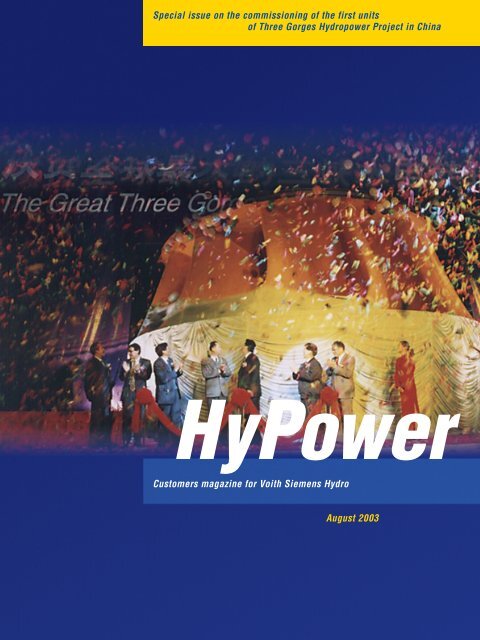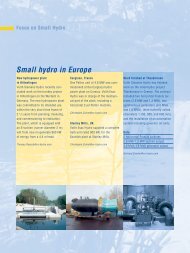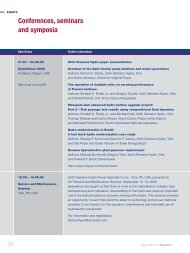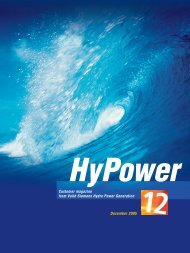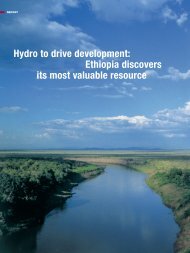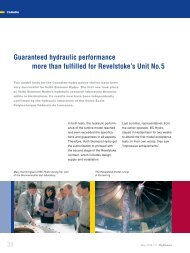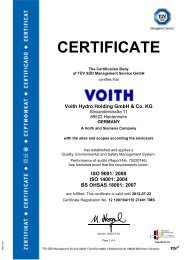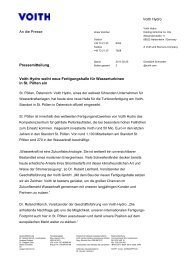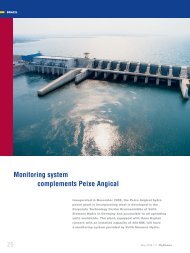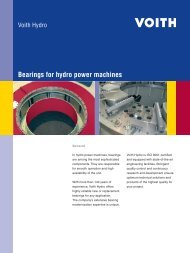Hypower Special Issue Three Gorges, China - Voith Hydro
Hypower Special Issue Three Gorges, China - Voith Hydro
Hypower Special Issue Three Gorges, China - Voith Hydro
Create successful ePaper yourself
Turn your PDF publications into a flip-book with our unique Google optimized e-Paper software.
<strong>Special</strong> issue on the commissioning of the first units<br />
of <strong>Three</strong> <strong>Gorges</strong> <strong>Hydro</strong>power Project in <strong>China</strong><br />
HyPower<br />
Customers magazine for <strong>Voith</strong> Siemens <strong>Hydro</strong><br />
August 2003
<strong>Hypower</strong> <strong>Special</strong> <strong>Issue</strong> <strong>Three</strong> <strong>Gorges</strong>, <strong>China</strong><br />
Congratulations to <strong>China</strong> Yangtze <strong>Three</strong><br />
on the commissioning<br />
A long anticipated moment happened on June 24, 2003: The first unit of<br />
the world's largest hydropower station was synchronized in the heart of the<br />
15 square kilometer site. For the first time, electricity was generated and<br />
fed into the public grid. This was the first of six units to be provided<br />
through the VGS consortium, which consists of <strong>Voith</strong> Siemens <strong>Hydro</strong> Power<br />
Generation and GE <strong>Hydro</strong>, Canada.<br />
Commissioning impressions:<br />
Cheering in front of the generator<br />
after 72 hours test operation<br />
of unit 2.<br />
Chinese and foreign experts<br />
preparing for the first<br />
synchronization.
<strong>Gorges</strong> Project Development Corporation<br />
of the first units<br />
<strong>Voith</strong> Siemens <strong>Hydro</strong> Power Generation<br />
is especially proud of being the first<br />
to hand over one of these gigantic<br />
units to <strong>China</strong> Yangtze <strong>Three</strong> <strong>Gorges</strong><br />
Project Development Corporation.<br />
This unit completed 72 hours commissioning<br />
operation on July 7 followed<br />
by 30 days of successful test<br />
operation. At the current reservoir<br />
level of 135 m the maximum generator<br />
output reaches 550 MW.<br />
The second VGS unit has also finished<br />
the 72 hours commissioning<br />
operation in the same reliable and<br />
successful manner as the first one<br />
and has now entered the 30 days<br />
test operation phase.<br />
The end of the 30 day test operation<br />
also marks the hand-over for commercial<br />
operation to <strong>China</strong> Yangtze<br />
<strong>Three</strong> <strong>Gorges</strong> Project Development<br />
Corporation. All tests carried out<br />
during this phase were done with<br />
excellent results and highest customer<br />
satisfaction.<br />
hypower special issue<br />
02<br />
03
<strong>Hypower</strong> <strong>Special</strong> <strong>Issue</strong> <strong>Three</strong> <strong>Gorges</strong>, <strong>China</strong><br />
Unit data<br />
Rated head 80.6 m<br />
Maximum head 113 m<br />
Minimum head 61 m<br />
Rated flow 996 m 3/s<br />
Rated power 700 MW<br />
Max. capacity 840 MVA<br />
Rated speed 75 rpm<br />
Rated frequency 50 Hz<br />
Rated voltage 20 kV<br />
Power factor 0.9<br />
Year of order 1997<br />
Runner diameter 10 m<br />
Runner weight 420 tons<br />
First runner manufactured<br />
by <strong>Voith</strong> Siemens <strong>Hydro</strong><br />
Shanghai<br />
Since project inception, the hydraulic<br />
and mechanical design of the<br />
turbines was a number one priority<br />
for the company’s Research and<br />
Development Team. The turbines are<br />
larger than those supplied for Itaipu<br />
in both size and weight, so welding<br />
and sourcing requirements had to<br />
be redefined to a new level of the<br />
state-of-the-art. The unparalleled<br />
experience of <strong>Voith</strong> Siemens <strong>Hydro</strong><br />
in large Francis turbines, in combination<br />
with air- or water-cooled<br />
generators provided an excellent<br />
technology base for this new design.<br />
The hydraulic performance, proven<br />
in witness tests of the turbine model<br />
in 1998, was an important milestone<br />
for the Corporate Technology Center<br />
in Heidenheim’s “Brunnenmühle”.
Velocity<br />
high<br />
Stator frame delivery ceremony in Shanghai Historic event in Brazil Rotor lowering at site<br />
Excitation: additional award<br />
Following the award for turbines and<br />
generators was a separate contract in<br />
2000 for <strong>Voith</strong> Siemens <strong>Hydro</strong> to<br />
supply the excitation systems for all<br />
14 units of the left bank powerstation.<br />
low low<br />
Pressure<br />
high<br />
International engineering and<br />
manufacturing alliance<br />
<strong>Voith</strong> Siemens <strong>Hydro</strong> Heidenheim, Germany<br />
has the project lead and also carried<br />
out the model tests for the turbines.<br />
<strong>Voith</strong> Siemens <strong>Hydro</strong> Shanghai, <strong>China</strong><br />
manufactured two 420 ton runners and<br />
other key turbine and generator components.<strong>Voith</strong><br />
Siemens <strong>Hydro</strong> São Paulo,<br />
Brazil supplied castings for the turbine<br />
runner blades and major generator components,<br />
including four stator windings,<br />
two stator cores, a frame, two generator<br />
rotors and auxiliary systems.<br />
The acknowledgement of the contribution<br />
from <strong>Voith</strong> Siemens <strong>Hydro</strong>’s<br />
Brazilian facilities was showcased<br />
when former Brazilian President,<br />
Henrique Cardozo, presented a photo<br />
of the first generator stator frame<br />
manufactured in São Paulo with all the<br />
employees gathered inside, to former<br />
<strong>China</strong>’s President, Jiang Ze Min, during<br />
his state visit to Brazil.<br />
<strong>Three</strong> <strong>Gorges</strong> model test<br />
in Heidenheim, Germany.<br />
hypower special issue<br />
04<br />
05
<strong>Hypower</strong> <strong>Special</strong> <strong>Issue</strong> <strong>Three</strong> <strong>Gorges</strong>, <strong>China</strong><br />
Next stage: <strong>Three</strong> <strong>Gorges</strong> II<br />
While design and engineering within<br />
the international alliance still requires<br />
enormous logistical effort from all<br />
<strong>Voith</strong> Siemens <strong>Hydro</strong> locations<br />
involved in this project, top level<br />
executives and project managers in<br />
the company’s Chinese and German<br />
locations are already planning for the<br />
future. Bid preparation for the right<br />
bank powerstation of <strong>Three</strong> <strong>Gorges</strong><br />
is in full swing. On the basis of the<br />
excellent design and performance from<br />
the machines in Stage I, as well as<br />
the close customer relationship developed<br />
during this phase, <strong>Voith</strong> Siemens<br />
<strong>Hydro</strong> is confident to be able to continue<br />
its support to the <strong>China</strong> Yangtze<br />
<strong>Three</strong> <strong>Gorges</strong> Project Development<br />
Corporation with solutions and stateof-the-art<br />
equipment for the largest<br />
power project ever built in <strong>China</strong>.<br />
Facts and figures<br />
The project is located in the Chinese<br />
province of Hubei, upstream from the<br />
city of Yichang. Project cost is estimated<br />
at 25 billion US Dollars.<br />
Main project objectives are flood<br />
control, power generation and<br />
improvement of navigation on the<br />
Yangtze River.<br />
Flood control will be achievable by<br />
controlling water flows in the summer<br />
season and providing controlled<br />
water discharge to the central and<br />
lower Yangtze regions. Thus an area<br />
of 1.6 million hectares, inhabited<br />
by 15 million people is protected.<br />
Historically, floods have killed thousands<br />
of people and made millions<br />
homeless at almost regular 10-year<br />
intervals.<br />
<strong>Three</strong> <strong>Gorges</strong> site at night<br />
During the 1998 flood, the cost of<br />
providing emergency protection for<br />
the city of Wuhan, other downstream<br />
cities and areas of cultivated land,<br />
combined with the cost of clearing<br />
up flood damage was comparable to<br />
the capital cost of the dam.<br />
The plant will provide electric energy<br />
mainly to Central and Eastern <strong>China</strong>,<br />
regions that enjoy strong economic<br />
growth. Also, the province of Sichuan<br />
will get a share of the plant’s total<br />
output of 18,200 MW.<br />
The project will generate 84.7 TWh<br />
annually, replacing about 50 million<br />
tons of raw coal burned in thermal<br />
plants. This will save 100 million<br />
tons of CO2, two million tons of SO2, 10,000 tons of CO, and 370,000 tons<br />
of NOx emissions.
<strong>Three</strong> <strong>Gorges</strong> dam under construction Artist view of the <strong>Three</strong> <strong>Gorges</strong> dam<br />
Ship navigation will be improved,<br />
making it possible for a 10,000 ton<br />
barge (compared to currently 3,000<br />
tons) to sail upstream directly to the<br />
harbors of Chongqing.<br />
Embedding the spiral case<br />
This will increase annual river transportation<br />
from 10 million tons to<br />
50 million tons, reduce transport<br />
costs by one third and result in significant<br />
improvements for the economic<br />
infrastructure of the inland provinces.<br />
New sources of food by the introduction<br />
of fish farming and aquaculture<br />
in the new reservoir have been part<br />
of the development plan since its<br />
beginning. A better supply of irrigation<br />
water to the newly developed<br />
farmland will also be achieved.<br />
The Chinese authorities plan to construct<br />
146 sewage treatment plants<br />
along the river to reduce current<br />
industrial and residential pollution<br />
into the Yangtze.<br />
History<br />
The first concepts for the gigantic<br />
project were initially developed by<br />
Dr. Sun Yat-sen at the beginning of<br />
the 20th century.<br />
The construction time from the site<br />
preparation to the final commissioning<br />
of the 26th unit in 2009 stretches<br />
over 17 years.<br />
hypower special issue<br />
06<br />
07
<strong>Voith</strong> Siemens <strong>Hydro</strong><br />
Power Generation GmbH & Co. KG<br />
Alexanderstraße 11<br />
89522 Heidenheim/Germany<br />
Tel. +49 7321 37 68 48<br />
Fax +49 7321 37 78 28<br />
www.voithsiemens.com<br />
Editorial coordination:<br />
Barbara Fischer-Aupperle<br />
Copyright 2003<br />
Reproduction permitted,<br />
provided source is given.<br />
10000 www.msw.de


